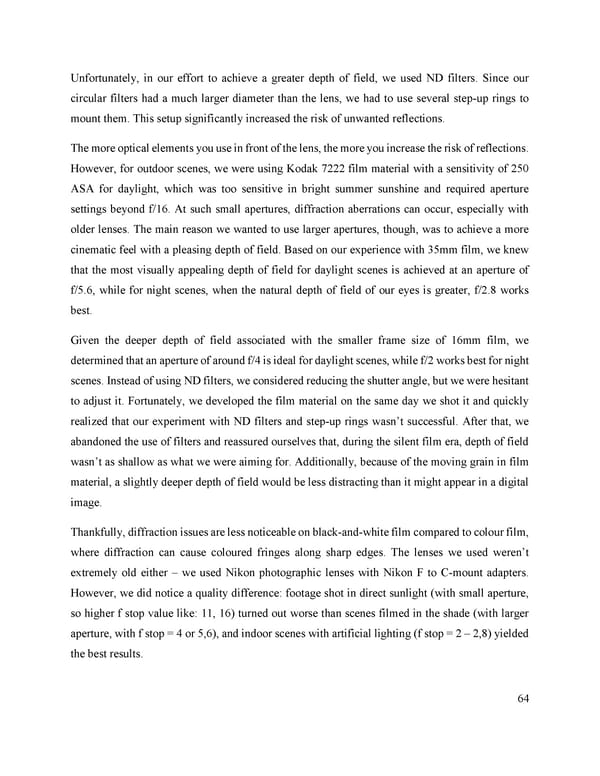Unfortunately, in our effort to achieve a greater depth of field, we used ND filters. Since our circular filters had a much larger diameter than the lens, we had to use several step-up rings to mount them. This setup significantly increased the risk of unwanted reflections. The more optical elements you use in front of the lens, the more you increase the risk of reflections. However, for outdoor scenes, we were using Kodak 7222 film material with a sensitivity of 250 ASA for daylight, which was too sensitive in bright summer sunshine and required aperture settings beyond f/16. At such small apertures, diffraction aberrations can occur, especially with older lenses. The main reason we wanted to use larger apertures, though, was to achieve a more cinematic feel with a pleasing depth of field. Based on our experience with 35mm film, we knew that the most visually appealing depth of field for daylight scenes is achieved at an aperture of f/5.6, while for night scenes, when the natural depth of field of our eyes is greater, f/2.8 works best. Given the deeper depth of field associated with the smaller frame size of 16mm film, we determined that an aperture of around f/4 is ideal for daylight scenes, while f/2 works best for night scenes. Instead of using ND filters, we considered reducing the shutter angle, but we were hesitant to adjust it. Fortunately, we developed the film material on the same day we shot it and quickly realized that our experiment with ND filters and step-up rings wasn’t successful. After that, we abandoned the use of filters and reassured ourselves that, during the silent film era, depth of field wasn’t as shallow as what we were aiming for. Additionally, because of the moving grain in film material, a slightly deeper depth of field would be less distracting than it might appear in a digital image. Thankfully, diffraction issues are less noticeable on black-and-white film compared to colour film, where diffraction can cause coloured fringes along sharp edges. The lenses we used weren’t extremely old either – we used Nikon photographic lenses with Nikon F to C-mount adapters. However, we did notice a quality difference: footage shot in direct sunlight (with small aperture, so higher f stop value like: 11, 16) turned out worse than scenes filmed in the shade (with larger aperture, with f stop = 4 or 5,6), and indoor scenes with artificial lighting (f stop = 2 – 2,8) yielded the best results. 64
 Lost Analogue: Exploring Film, Music, and Interdisciplinary Methods in Education Page 64 Page 66
Lost Analogue: Exploring Film, Music, and Interdisciplinary Methods in Education Page 64 Page 66